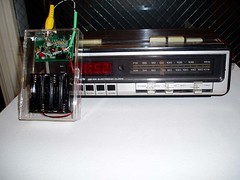Radio has been declared dead many times, especially with the rise of the internet. When streaming audio became practical in the late 90s it was often declared that every person with a ‘net connection would have her own station. The birth of satellite radio, with hundreds of channels of narrowcasted nationwide channels, brought more exclamations. In the last eighteen months podcasting has been the latest rhetorical nail in radio’s coffin, joining ‘net radio’s promise of “every person a broadcaster” with the multi-channel appeal of satellite radio.
But radio isn’t dead. Rather, it’s strangely revitalized.

The death of radio is really the death of one dominant mode of radio — commercial music radio. Although media scholars and activists have been sounding the warning bells about media consolidation since 1996, finally the mainstream has gotten wise to the destruction it wrought on the radio dial. Internet radio, satellite radio and podcasting are all heralded as more diverse, interesting and independent alternatives. And I agree.
It’s true that radio is no longer the undisputed king of audio entertainment. Radio now has competition and will never be #1 again. But there’s an enormous gulf between not being #1 and being dead.
What’s most interesting to me about podcasting is that it has brought about renewed interest in the art of radio production. Of course, this trend converges with the increasing availability of inexpensive high quality audio equipement. Yet, three years ago most folks interested in audio recording seemed to be more oriented towards home music production.
Now, however, people are once again in recording speech and producing interesting talk content for podcasts. And they’re interested in doing it well.
Radio production is not a lost art. Just tune in to your local NPR or community radio station to hear compellingly produced talk programming. In the 1990s the public radio program “This American Life” arguably single-handedly revitalized the art of the audio documentary on public radio. In the mid-00s, the revitalizer is podcasting.
The conclusion that podcasting is revitalizing radio came to me just yesterday when I picked up the January issue of Electronic Musician and saw that the lead article is “Expert Advice on the Art of Podcasting.”
It struck me a bit amazed that here we are in 2006 and people are getting excited about producing programs for radio, a medium that’s over 80 years old. They’re not interested in radio just to play the same 40 songs over and over, or for hearing the weather and traffice. They’re interested in using radio to communicate their ideas and experiences. To produce documentaries, comedy and drama.
Sure, most podcast programs will never be heard on actual airwaves, but some will. And some of those podcasters will decide to get into broadcast radio–community, public or even commercial–as a result of that experience.
Podcasting has kicked the public conception of radio out of the Clear Channeled doldrums of voicetracked robot DJs back into a realm where it can be relevant medium for meaningful communication. Unfortunately, the media giants like Inifinity still control the vast majority of stations, and therefore they stand as the single greatest impediment to the holistic revitalization of radio. But even they cannot kill radio altogether.
The revitalization is happening on public, community and low power stations. And, in some rare exceptions, on commercial stations willing to take the risk of offering up something besides reactionary blowhards and a relentless cycle of headlines-sports-weather-traffic every ten minutes. It’s on the margins now (though public radio is more mainstream than we tend to give it credit for being), but that’s where change happens.
More personally, as a broadcast community radio producer myself, podcasting has increased my listenership, my reach and my motivation to produce. I’ve been posting my radioshow on-line on a regular basis since 2002. And I definitely had listeners on-line, though it seemed erratic.
But when I first started a podcast feed fourteen months ago, I saw an increase in listeners, in addition to an increase in awareness as measured by email feedback. Presently each edition of the program sees on average about 300 downloads, with some programs (like the Oct. 28, 2005 edition) going over a thousand.
300 listeners may not seem like a ton compared to the biggest podcasters and broadcasters, but, realistically, that equals about as many people hear the radioshow live on the radio in Champaign-Urbana, IL. Thus podcasting, in effect, doubles the number of listeners to my radioshow. I consider that significant, and it motivates me to be more consistent with the program.
Because of that consistency and increased audience I now have 6 affiliate stations around the nation. I do believe these factors are all related.
Podcasting is not radio, but the only real difference is the medium of transmission — their modes of production are identical. As a radio broadcaster I welcome the podcasters as comrades, not competitors. As a podcaster, I owe a debt to the broadcasters. Wearing both hats, I’m glad to see so much radio content get produced.
Leave a Reply